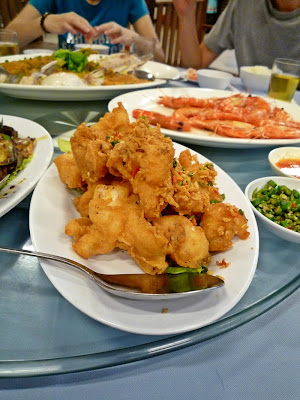The Larut Wars (1861-1874)
The Larut wars in Perak are the stuff for a thrilling Hong Kong style historical-fictional movie. It's a wonder why no movie director has deemed them fit to adapt them into a movie replete with gangland warfare, gore and blood. What could have been more thrilling: a turf war fought over 13 years, an adulterous love affair, a final battle involving rival chiefs to the Perak throne? At the height of the battle between two secret societies, the Hai San, comprising primarily of the Hakka clan and the Ghee Hin of the Hokkien clan, and a sprinking of other lesser known dialect dominated secret societies taking sides, there were over 40,000 Chinese tin miners in Perak.
According to Isabella Bird,

The First Larut War was sparked by a fight over control of water courses to the tin mines between the rival secret societies. The Second, over a gambling quarrel between rival members. Story has it that the Hai San took 14 Ghee Hin members prisoners, 13 of whom were killed while one escaped. In retaliation the Ghee Hin razed a Hai San village, killing 40 men. The Third War erupted over a scandalous affair between a Ghee Hin leader and the wife of the nephew of the Hai San supremo. The adulterous pair was captured, put into a pig basket and thrown into a disused mining pool. To avenge the death of their Ghee Hin leader, the Ghee Hin imported 4000 professional fighters from China. The onslaught drove the Hai San members, numbering about 10,000 fleeing to Penang. The Final Larut War, which involved the rival chiefs to the Perak throne and supported by both the societies, was finally settled with the intervention of the British in the Pangkor Treaty in 1874.
The Larut wars in Perak are the stuff for a thrilling Hong Kong style historical-fictional movie. It's a wonder why no movie director has deemed them fit to adapt them into a movie replete with gangland warfare, gore and blood. What could have been more thrilling: a turf war fought over 13 years, an adulterous love affair, a final battle involving rival chiefs to the Perak throne? At the height of the battle between two secret societies, the Hai San, comprising primarily of the Hakka clan and the Ghee Hin of the Hokkien clan, and a sprinking of other lesser known dialect dominated secret societies taking sides, there were over 40,000 Chinese tin miners in Perak.
According to Isabella Bird,

The First Larut War was sparked by a fight over control of water courses to the tin mines between the rival secret societies. The Second, over a gambling quarrel between rival members. Story has it that the Hai San took 14 Ghee Hin members prisoners, 13 of whom were killed while one escaped. In retaliation the Ghee Hin razed a Hai San village, killing 40 men. The Third War erupted over a scandalous affair between a Ghee Hin leader and the wife of the nephew of the Hai San supremo. The adulterous pair was captured, put into a pig basket and thrown into a disused mining pool. To avenge the death of their Ghee Hin leader, the Ghee Hin imported 4000 professional fighters from China. The onslaught drove the Hai San members, numbering about 10,000 fleeing to Penang. The Final Larut War, which involved the rival chiefs to the Perak throne and supported by both the societies, was finally settled with the intervention of the British in the Pangkor Treaty in 1874.





























































